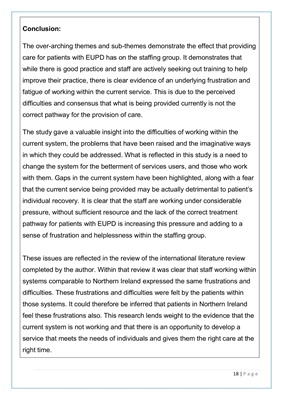
18 | P a g e
Conclusion:
The over-arching themes and sub-themes demonstrate the effect that providing
care for patients with EUPD has on the staffing group. It demonstrates that
while there is good practice and staff are actively seeking out training to help
improve their practice, there is clear evidence of an underlying frustration and
fatigue of working within the current service. This is due to the perceived
difficulties and consensus that what is being provided currently is not the
correct pathway for the provision of care.
The study gave a valuable insight into the difficulties of working within the
current system, the problems that have been raised and the imaginative ways
in which they could be addressed. What is reflected in this study is a need to
change the system for the betterment of services users, and those who work
with them. Gaps in the current system have been highlighted, along with a fear
that the current service being provided may be actually detrimental to patient's
individual recovery. It is clear that the staff are working under considerable
pressure, without sufficient resource and the lack of the correct treatment
pathway for patients with EUPD is increasing this pressure and adding to a
sense of frustration and helplessness within the staffing group.
These issues are reflected in the review of the international literature review
completed by the author. Within that review it was clear that staff working within
systems comparable to Northern Ireland expressed the same frustrations and
difficulties. These frustrations and difficulties were felt by the patients within
those systems. It could therefore be inferred that patients in Northern Ireland
feel these frustrations also. This research lends weight to the evidence that the
current system is not working and that there is an opportunity to develop a
service that meets the needs of individuals and gives them the right care at the
right time.